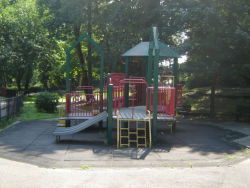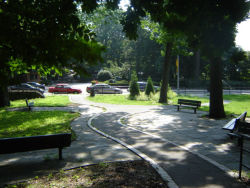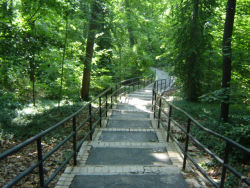Brust Park
Brust Park
What was here before?
The Weckquaesgeek Lenape occupied the site that is now Brust Park. In 1639, the Dutch East India Company brought the first Europeans to settle what is now the Bronx. In 1646, Dutchman Adriaen Van Der Donck (1620-1655) received the first patent to this land. After he died, the property was purchased by Frederick Philipse, a powerful, unscrupulous landowner and British Loyalist, who lost his property at the end of the Revolutionary War.
Philpse’s southern neighbor, local farmer William Hadley acquired the property and ultimately sold 257 acres to Major Joseph Delafield in 1829. Delafield, veteran of the War of 1812 and president of the New York Lyceum of Natural History (now New York Academy of Sciences), used the property as a country retreat and to operate a profitable lime kiln. By 1882 the family mapped out winding streets on the property, a rural feature opposed to the city grid, and started to sell plots of land by 1910. Shortly thereafter the planned community was named Fieldston, purportedly after the Delafield family seat in Ireland, and by the 1920s most of the property had been liquidated.
How did this site become a park?
One of the oldest parks in Riverdale, this property was acquired by the City through condemnation for the Spuyten Duyvil (now Manhattan College) Parkway in 1882.
Brust Park increased in size in 1951 when Dash Place, a minor road dividing the park, was eliminated and the land was incorporated into the park. A major reorganization in 1964 eliminated Fieldston Road between West 238th Street and West 242nd Street, as well as the section of West 242nd Street between Fieldston Road and Greystone Avenue which added parkland. In 1998 NYC Parks added a tot play unit and multi-colored play equipment. Most of the sloping park is enveloped with mature trees with several winding pathways and benches for relaxation.
Who is this park named for?
The parkland remained nameless until March 29, 1940, when Mayor Fiorello H. LaGuardia (1882-1947) designated it Brust Square in honor of Corporal Charles Brust, a soldier who died in combat during World War I. Brust Square was renamed Brust Park by Parks Commissioner Henry J. Stern in 1997. Though Corporal Brust was not a resident of this Riverdale neighborhood, he did live on Hull Avenue in the Bronx when word came that he was going overseas to fight for his country in the 105th Infantry. Corporal Brust was killed on August 30, 1918.
Check out your park's Vital Signs
Clean & Safe
Green & Resilient
Empowered & Engaged Users
Share your feedback or learn more about how this park is part of a
Vital Park System



